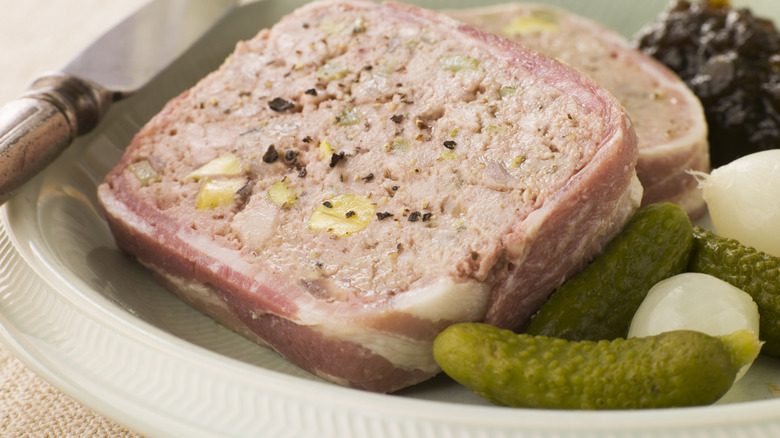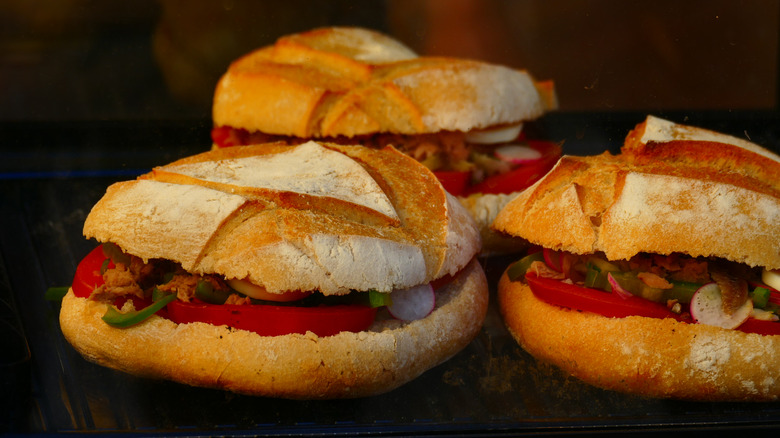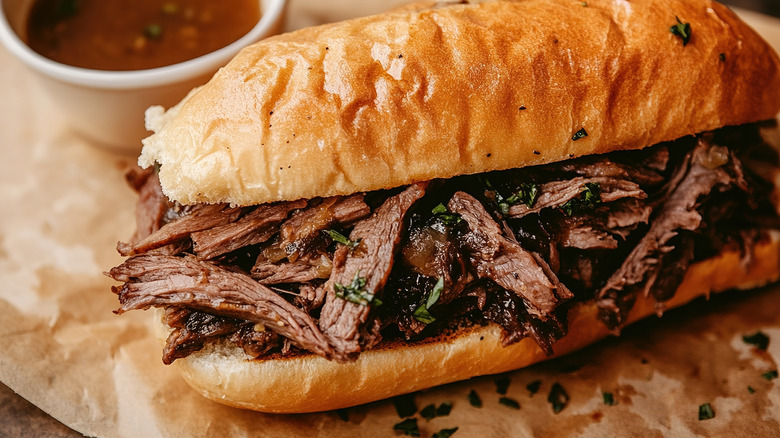11 French Sandwiches You Should Know About
If the popular legend is true, sandwiches are an English creation, first devised by a British noble as an efficient way to keep himself fueled during card games. But cultures around the world have made sandwiches their own — a lunch box or brown bag with an old-school peanut butter and jelly sandwich has long been a default lunch for schoolkids and office workers alike in the U.S. In France — a country known for its elevated food culture and elaborate culinary creations — the simple sandwich has taken a life of its own, becoming a favorite quick lunch or snack at cafés and picnics.
As a longtime Francophile (I lived in France for close to three years, part of that time as a live-in nanny for a French family), I had the good fortune to sample more French-style sandwiches that I can count. They were not only eminently crave-worthy, but affordable — an important factor for a recent college grad living on a nanny's salary. And while they're distinct enough to add Continental flair to your next picnic or potluck, most of them can be easily assembled with common American ingredients. Even better, they're diverse enough to fit every mood and appetite — and all are well worth checking out.
Croque monsieur
One of the first elements of French culture everyone learns about in introductory French courses, the croque monsieur is the French analogue to a grilled cheese sandwich — a simple, everyday pleasure found in nearly every café or quick service restaurant. It's basically a grilled ham-and-Gruyère sandwich with a broiled cheesy topping, typically a thin layer of béchamel sauce and grated cheese. A distinguishing feature of the croque monsieur is that it's made not on a baguette, but on sliced white sandwich bread (pain de mie), which is common in France.
A typical croque monsieur is flavorful, but far from extravagant — while it's meant to be a fork-and-knife sandwich, don't expect thick layers of meat or lots of oozing cheese. It makes for a satisfying quick lunch if you're not too hungry, or a hearty mid-afternoon snack if you have a bigger appetite. If you like the idea of a croque monsieur but want something more substantial, try its close relative, the croque madame — the same sandwich, but topped with a fried egg. If you're curious to make one yourself, try our traditional croque madame recipe.
Jambon beurre (ham and butter)
France may be known for the complexity of its cuisine and its elaborate sauces and pastries with dozens of ingredients, but some of the country's most-beloved dishes are its simplest. A case in point is the classic jambon beurre (ham and butter) sandwich. And yes, that's all it is: a split segment of baguette, a smear of butter, and a few layers of boiled ham. It's not exactly high drama, but it's filling and comforting — and if done right, supremely satisfying.
Because the sandwich is so simple, it's critical to make it with good-quality ingredients. A fresh, warm baguette is a must — it has to be nice and crusty outside and tender within. And use the best and richest unsalted butter you can find, preferably 85% butterfat. Finally, use good-quality, mild boiled ham, such as prosciutto cotto or jambon de Paris — this gentle sandwich is not the place for salty Virginia ham or prosciutto di Parma, tasty as these may be in other contexts.
Pâté with cornichons
When Americans think of French finger food, they often think of pâté, baguettes, and delicate little cornichons. And they wouldn't be wrong — these are indeed everyday favorites in France. Indeed, any corner café in France that offer sandwiches (most of them do) will have pâté as one of the choices, and dinner parties commonly start with baguette slices, a plate of cornichons, and a chunk of pâté set out for DIY hors d'oeuvres.
While you can find dozens of pâté types in France, ranging from warm layered pâtés wrapped in pastry to smooth chicken liver pâté flavored with brandy, the type you're most likely to find in a corner café sandwich is the classic pâté de campagne, or country pâté — a hearty, coarse, and firm pâté of pork, pork liver, herbs, and garlic. Combined with a crusty fresh baguette, it's bold and flavorful enough to make a great sandwich by itself — but a bit of mustard and a few tangy, crunchy cornichons make it even better.
Rillettes sandwich
Rillettes, a coarse, spreadable cousin of pâté, doesn't get the love it deserves from North American diners. A likely reason for this is it's extravagantly and unapologetically fatty — it's basically seasoned, long-simmered pork (and/or duck) that is finely shredded and stored in its cooking fat, which remains visible in the finished mixture. The rich, spreadable treat, sold in jars or tubs in France and served cold, is another common sandwich option in France.
While it's indeed rich (and definitely not a good choice for calorie counters), it doesn't taste like a mere mouthful of fat. It packs a punch in terms of flavor — deeply meaty and savory, typically shot through with aromatics such as garlic and rosemary. And its buttery mouthfeel makes it a great partner for a crispy fresh baguette. A typical rillettes sandwich doesn't contain anything other than rillettes and bread. But it's so powerfully flavored it doesn't need anything more than that.
Oeuf dur crudités (sliced eggs and vegetables)
Good news for vegetarians: Not all traditional French sandwiches are meat bombs. If you're hungry for a filling but meatless sandwich option, seek out oeuf dur crudités — sliced hard-boiled eggs and fresh raw vegetables, typically lettuce and tomatoes, layered on a baguette, and usually with a light smear of mayo. It's not only a whole lot prettier than an egg salad sandwich, but somehow manages to taste both lighter and more substantial than egg salad at the same time.
Even better, this is a sandwich that fits easily into the American kitchen. While you might have to do some hunting to find authentic French-style pâté or rillettes, most of us can easily find a passable baguette, eggs, and fresh vegetables. If you like, you can liven your sandwich up with a light vinaigrette or mix up your choice of veggies (for instance, thinly sliced cucumbers, bell peppers, or onions are possible options). This is a fun sandwich to make and eat because it puts an unexpected twist on a bunch of familiar ingredients. So, if you're looking for an easy vegetarian option for your next picnic, look no further.
Pan bagnat
If you've always disliked tuna sandwiches because gloppy mayonnaise mixtures gross you out, pan bagnat – a specialty from the sunny southeast coast of France — may change your mind. This colorful sandwich, filled with a summery mix of tuna chunks, bits of anchovy, vegetables such as tomatoes, radishes, cucumbers, and onions, along with sliced hard-boiled eggs, and generous lashings of olive oil and vinegar, is essentially a handheld salade Niçoise. But what makes the sandwich truly unique — and gives it its name, which translates as "soaked bread" — is the fact that the hearty round rolls used for the sandwich are pressed for an hour or more after the sandwiches are filled. This allows the juices from the filling to permeate the bread, adding another dimension of flavor.
While the pan bagnat evolved as a convenient way for fishermen and other workers to enjoy a portable meal of readily available ingredients, the sandwich has now become such a cultural icon and point of local pride that an organization, the Commune Libre du Pan Bagnat, is dedicated to promoting and protecting the sandwich and its heritage. Among the group's projects is a list of essential ingredients (including tomatoes, green peppers, and fava beans), and acceptable options for add-ins (such as vinegar, artichokes, and garlic). Whether or not you choose to follow their rules, pan bagnat makes a next-level beach lunch.
Pain au chocolat (bread with chocolate)
To French eaters, the term pain au chocolat (literally, bread with chocolate) refers to two distinct preparations: The first is the one more familiar to Americans, a flaky roll of croissant dough wrapped around a stick of bittersweet chocolate. The second is almost unknown to Americans, but an everyday snack for French families: a length of baguette with a stick of bittersweet chocolate stuck down its middle.
I first encountered this second type on a bus trip during my junior year abroad in Tours, France. During the long ride, our trip organizers handed each of us one of these treats, and at once, every student on the bus had the same thought: "Where has this been my entire life?" I got to see (and make) this many times again during my nannying stint. Every afternoon at 4 p.m., I'd cut a fresh baguette into age-appropriate lengths, stick a knife down the middle of the soft white crumb of each segment to form a slot, then stuff each slot with a few segments broken off a chocolate bar before handing them off to my charges. It's just that easy — and more flavorful than its simple ingredients may suggest.
French-style hot dogs
First things first: A hot dog is, indeed, a sandwich. And while the French have historically turned their noses down at American fast food, they've also not-so-secretly embraced it, as the preponderance of burger joints in large French cities can attest. But a closer look at a French fast food menu reveals that local cooks put their own distinctive touches on the American favorites – McDonald's French menu, for instance, features such touches as curry or cocktail sauce options for fries.
Even the all-American hot dog gets a welcome Gallic twist. When waiting at a Paris train station, I noticed a food stall offering hot dogs, and wondered why anyone would order one with so many other great sandwich options available. But hungry commuters did order them — and when they did, the vendor would pull out not a boring soft bun, but a length of a fresh baguette, which he'd impale on a stout metal rod before sliding in a heated hot dog. This preparation leaves little room for condiments apart from a squirt of mustard, but it's neat to eat, a plus if you're on the go. And the crunchy crust, pillowy bread, and juicy sausage offer a tantalizing mix of textures.
Merguez
Like many European powers, France has embraced the food of its former colonies. Moroccan and Algerian bakeries filled with honey-soaked treats abound in Paris and other major cities, and French families look forward to nights out feasting on couscous as much as they enjoy their steak frites. These North African influences even extend into France's sandwich culture: A popular street food, both for casual lunches and late-night snacks, is a sandwich filled with merguez, a spicy, garlicky lamb or beef sausage introduced to France by émigrés from its former colonies.
The typical merguez sandwich is a cross-cultural collaboration. It's built on a classic French baguette, split open and spread with harissa, a North African hot red chili paste. On top of this goes the hot sausage and sometimes add-ins such as grilled onions, peppers, or a bit of tomato. To make the sandwich even heartier — and to balance out its punchy flavors — some diners top their sandwiches with a handful of fries, adding another classic French note to the mix.
Tomato, goat cheese, and herbs
The south of France is known for its vibrant, summery foods, including the extravagant salad Niçoise, freshly caught fish, and refreshing wines. And the sandwiches often encountered there reflect this vibe. Among them is another meatless treat: a baguette filled with sliced ripe tomatoes, creamy goat cheese, and fresh herbes de Provence. A touch of olive oil helps hold everything together.
You can find this sandwich served either hot or cold – the hot version is often pressed, adding extra crunch and texture. It's best — and most authentic — if you make it with a flavorful cheese with a bloomy rind, such as Bucheron, which better balances the flavors of the tomato and bread than a regular fresh goat cheese. But even if all you can find is fresh goat cheese, it still makes a terrific sandwich — colorful, savory, and not too heavy, with a fun and satisfying mix of flavors and textures.
French dip
Let's set the record straight: The French dip sandwich — a crusty roll stuffed with hot meat and served with flavorful meat juices for dipping — isn't really French. It actually originated in Los Angeles sometime in the early 20th century. But according to one of its two competing origin stories, the restaurant owner who invented it was a French immigrant, Philippe Mathieu. Numerous variations on Mathieu's story exist, but the overall gist is this: Sometime in 1918, Mathieu accidentally dropped a roll into a pan of drippings while preparing a sandwich for a customer. The customer insisted on taking the sodden sandwich and loved it, so much so that his friends started asking for their sandwiches with a juice dip, too. The newly popular sandwich got its name from Mathieu's ethnicity as well as a fashion trend: At the time, the term French dip referred to a then-popular dropped waistline on dresses.
But another L.A. restaurant, Cole's Pacific Electric Buffet, also claims to have invented the sandwich, and offers a nearly identical origin story — an early cook at the restaurant inadvertently dropped a roll into some pan juices while assembling a sandwich, and magic happened. However, the case for Mathieu as inventor seems better documented, and would better explain how the sandwich came to be associated with French cuisine — even though the only thing French about it is its inventor.











